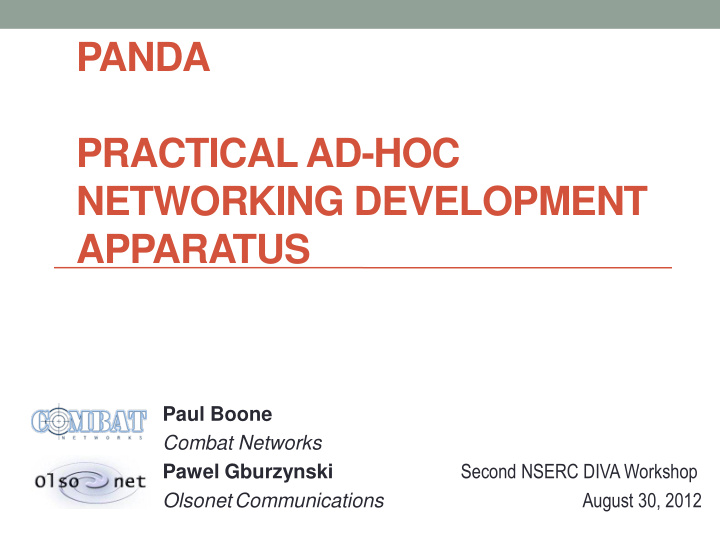



PANDA PRACTICAL AD-HOC NETWORKING DEVELOPMENT APPARATUS Paul Boone Combat Networks Second NSERC DIVA Workshop Pawel Gburzynski August 30, 2012 Olsonet Communications
Background • No shortage of ideas for WSN applications (see DIVA – and the next slide) • Applications tend to be one-of (custom) • Confusions and trade-offs: • Devices (footprint, energy, cost, massive deployment) • Software (rapid development, implications for device footprint) • Algorithms, protocols (feasibility, multi-hop communication) • No general purpose development toolkit for this class of applications
Collaborative Effort • Working together to produce wireless ad-hoc networking based applications: – PANDA : Complete ad-hoc networking design tool (SDK: PicOS, IDE, simulator/emulator + hardware) – Applications – Ariadne : Distributed Localization (a project with DIVA) – FRACTA : Freight Monitoring System – ILIAD : Independent Living Inconspicuous Anomaly Detector – Seawolf : Social Networks – EcoNet : Environmental Monitoring – IKiosk : Interactive Displays
Freight Monitoring
ILIAD (anomaly detector)
Seawolf (proximity-based social net) Small device paired via Bluetooth with a smartphone application, used to detect others in close proximity and “sense” their profiles. Bluetooth Link Wireless Ad-hoc Link
PANDA: the enabling concepts • PicOS (how to program tiny devices, so they act big). • VUEE (rapid development, “virtually” authoritative verification, demonstrations, domain specific extensions, mobility). • TARP (how to harness WSN nodes, so they truly collaborate, instead of getting in each other’s way) . • SDK: a glue for the above + experimental hardware and IDE (Windows/Linux).
PicOS System Layout This part can be re-compiled and executed in a virtual environment called VUEE (Virtual Underlay Execution Engine)
PicOS • Small footprint OS for organizing multiple activities of embedded reactive applications. • C style programming. • Application (praxis) defined as a set of FSMs. • Advantages over TinyOS: • Greater flexibility with dynamic memory allocation – even with devices with < 1K RAM. • All program dynamics available to program captured with PicOS threads rather then ISRs (callbacks).
VNETI – Versatile Network Interface • Collection of APIs independent of the underlying network. • Enables rapid development of networked applications for microcontrollers. • Layer-less. • Ability to add plugins (eg. TARP can be replaced with another routing protocol implementation).
VUEE - Virtual Underlay Execution Engine • Emulator for PicOS applications and their underlying networks. • Can simulate communications, sensors, energy use, etc. • Verify application functionality. • XML files used for configuration (network parameters, mobility, sensor info etc.) • Well defined interfaces/protocols make it easily extended.
PANDA: sample wireless nodes
PANDA: sample deployments
PANDA: visualization (snippets)
PANDA Demonstration
Find & Contact Us Online www.comip.ca Paul Boone pboone@combatnetworks.com www.olsonet.com Pawel Gburzynski pawel@olsonet.com Wlodek Olesinski wlodek@olsonet.com
Questions?
More information • http://www.olsonet.com/ • http://www.comip.ca/ - Visit us for a personal demonstration at ... - Seminars
Recommend
More recommend